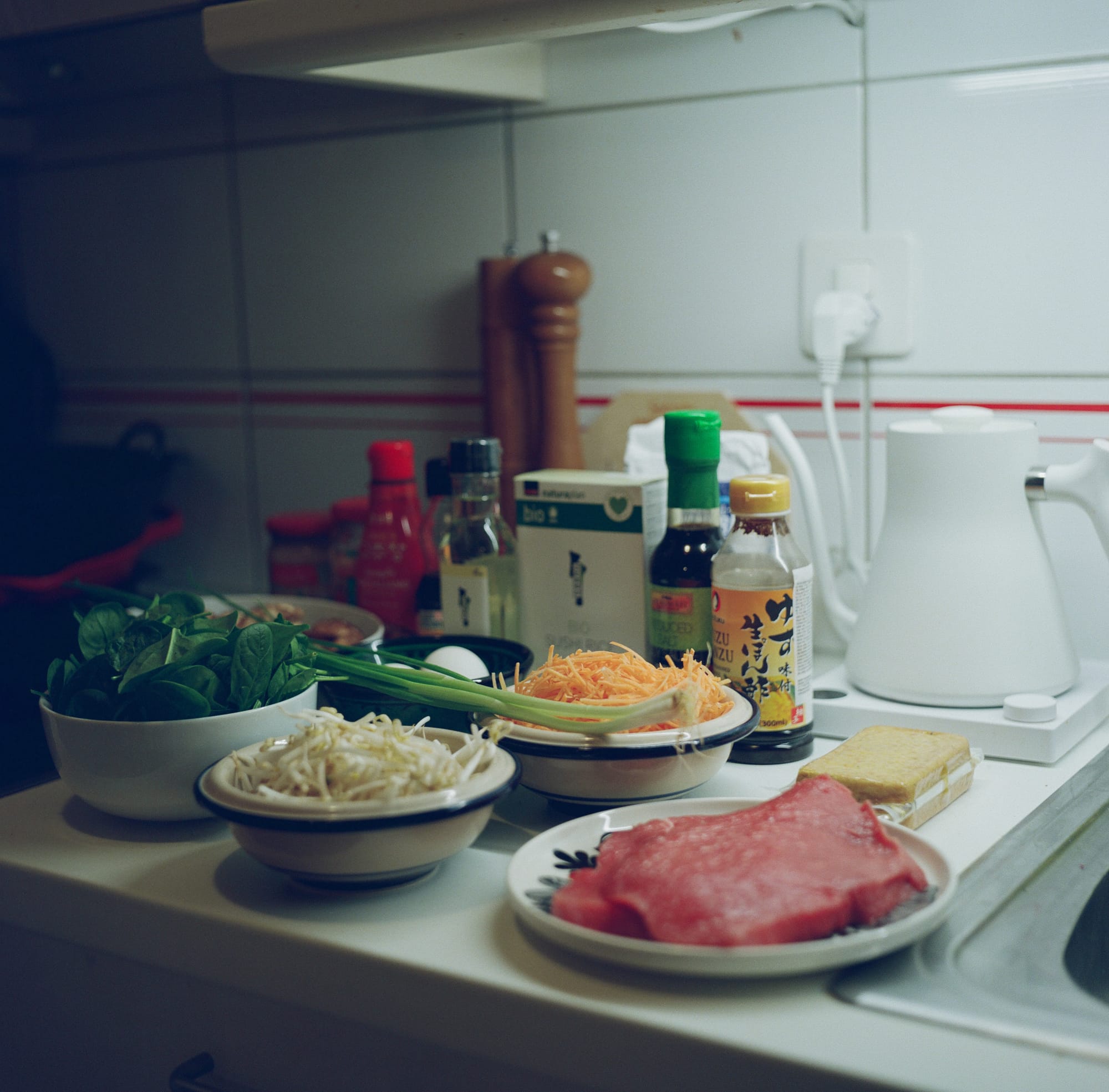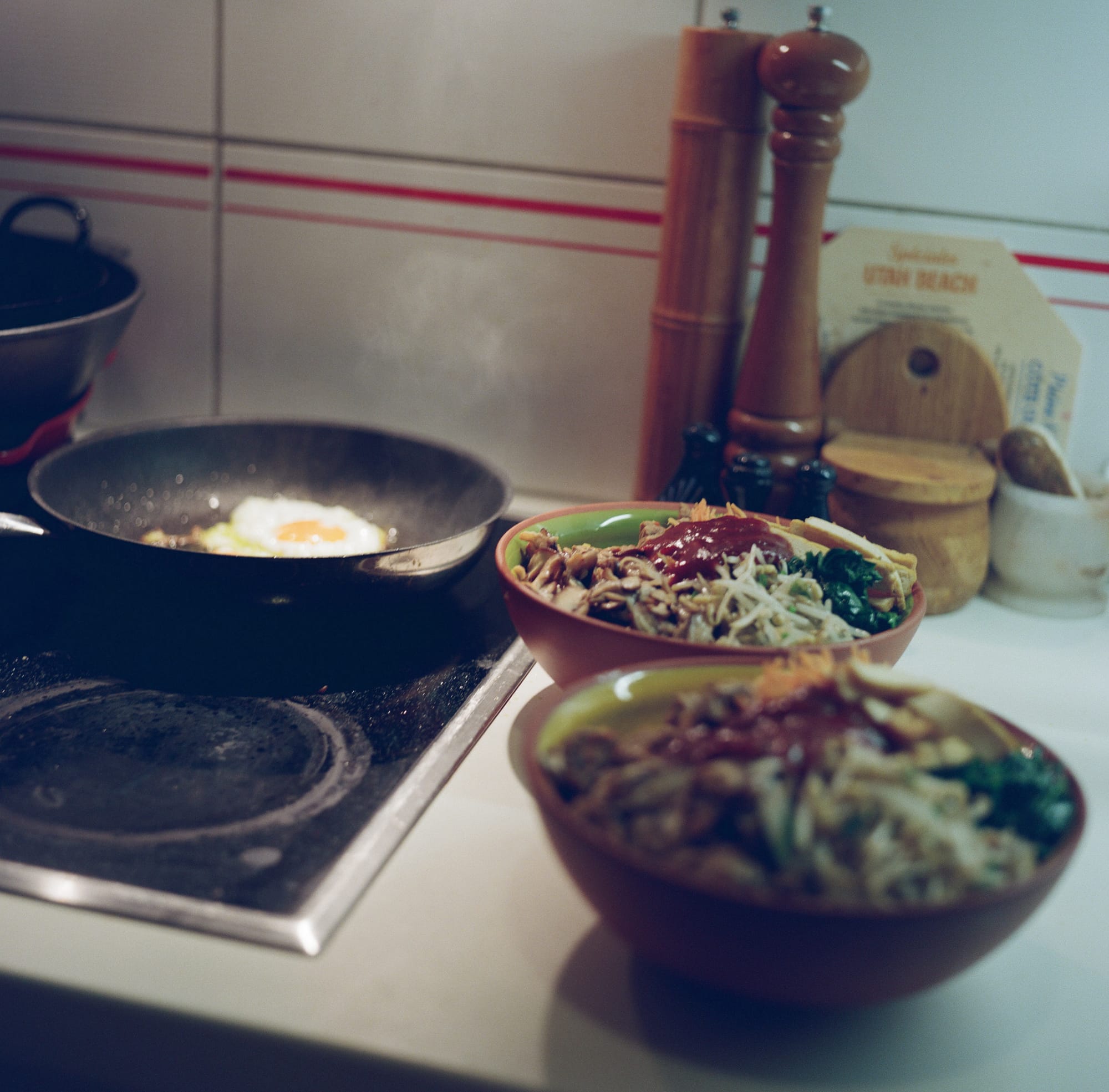What to eat SOUTH KOREA 🇰🇷 Bibimbap
Bibimbap is a dish with many competing origin stories just as it is a dish of many flavors... The four main narratives of bibimbap’s origin are complemented by the five main flavors – or colors – found in the dish itself.

Bibimbap
Published May 16, 2025 · by Amanda Rivkin Häsler
Bibimbap is a dish with many competing origin stories just as it is a dish of many flavors. Unlike most national dishes with competing origin stories, though, it is possible that all of the tales of this hearty Korean dish of rice and vegetables with just a bit of meat might possibly be true all at once.
Etymologically, “bibim” refers to mixing and “bap” is cooked rice. A dish consisting of warm rice topped with vegetables and the delicious chili pepper paste gochujang, with common additions including sliced meat, often beef, and a fried egg. The ingredients are then thoroughly stirred together.

The four main narratives of bibimbap’s origin are complemented by the five main flavors – or colors – found in the dish itself. First is the haute cuisine version which relays the dish came about as a casual palace affair, such as when a relative might visit the king. Competing with the king are the spirits. With many dishes prepared to pay respects and share with the spirits, the leftovers of such rites were simply added over rice and consumed as bibimbap.
The two remaining origin tales are more quotidian and belong to the lives of ordinary Koreans. As it is a traditional dish on the eve of the lunar new year, it is also possible bibimbap began as a part of annual pantry and later fridge clearing to begin the lunar year anew. Lastly, is the possibility that bibimbap’s origin story is quite humble, beginning with simple farmers whose needs were rather based on hearty sustenance to continue on with their work in the fields.
The earliest names on record for the dish we know today as bibimbap today appeared in the late sixteenth century. Before the development of the modern Korean alphabet, Chinese characters were used as a stand in, creating a Sino-Korean form of writing referred to today as Hanja characters. In 1590, the name “hondon-ban” first appeared in the Yeokjogumun portion of the book Historical Notes of Gijae written by Bak Dongnyang. Subsequent texts over the next two and a half centuries referred to the dish we know as bibimbap today as “goldong-ban” and simply “goldong”.
In 1810, bibimbap was first recorded in the modern Korean alphabet known as Hangul in the encyclopedia Mongyupyeon by Jang Hon. Even with the advent of Hangul though, Hanja characters were still co-existing in the written space of Korean literature and literacy. Even as late as 1870 the encyclopedia Myeongmul giryak provided the name “goldong-ban” in Hanja characters.
By the late nineteenth century, however, various names were given for the dish in the Hangul alphabet, all similar to the variation we know today as bibimbap. It is around this time that the first known recipe for bibimbap appeared in an anonymous cookbook of the late nineteenth century known as Sinjeonseo.

As a dish, bibimbap relies on the Yin-Yang and Five Elements Theory which are believed to govern the universe in Korea as well as China. Greens such as spinach, water parsley and green pumpkin are believed to improve the function of the liver. White elements such as egg white, radishes and chestnuts are supposedly good for the lungs. Red is said to be good for heart health, represented by foods such as carrots, peppers, gochujang and seasoned raw beef. Black foods like black sesame, mushroom and dried seaweed are allegedly good for the kidneys while yellow foods like soybean sprouts, egg yolk and pumpkin are good for the stomach. While the five major organs of the body are covered, the theory is not fully supported by science though there is some evidence to refute the whole gestalt.
Bibimbap has clearly existed in Korea for centuries and predates mass literacy on the Korean peninsula (and modern science, it seems), hence the likely late entry of not just the word itself into the written record but also the formalizing of a proper written recipe. The tradition of the Korean table with little dishes dates back to the tenth century and the Koryo dynasty. An article in The Journal of Ethnic Foods in 2015 argues that the birth of bibimbap “was inevitable considering the basic structure of the Korean meal table,” with many small dishes being served alongside a small bowl of rice.
In fact, personal diaries and essays dating to the Joseon dynasty, which lasted from 1392 until 1897, “often described a ‘koldongban,’” the earlier name for bibimbap, “like world,” which is say a “disordered and chaotic world.” These references also reveal that bibimbap was a common dish not just among ordinary Koreans but officials and nobility as well.
The twentieth century partition of the Korean peninsula into North and South Korea has also led to a split in forms of bibimbap, with Pyongyang, the capital of the completely antidemocratic Democratic People’s Republic of Korea (DPRK), becoming known for its vegetable bibimbap. Presumably this has nothing to do with rations, a shortage economy brought on by poor central planning or the widespread poverty the North is known for.
Regardless of how bibimbap began its journey from its origins somewhere on the Korean peninsula to everyday and commonplace as a globalized cuisine in the world today, as Food & Wine noted in 2022, “bibimbap is a versatile dish that appeals to everyone, from farmers to kings,” one that is “well-designed for casual convenience.” Surely the Koryo palace cooks back in the day were relieved when just a relative as opposed to a visiting dignitary arrived – as relieved as a casual diner in California or wherever really is to have a hearty bowl of bibimbap before them.
With the fascination of all things Korean from pop music to beauty products and food in recent decades, bibimbap has also become a dish of the international culinary lexicon and therefore highly customized based on geography and the availability of seasonal produce. The authors of The Journal of Ethnic Foods article argue that bibimbap attracted more interest than other Korean dishes in part because unlike the traditional Korean table of many appetizers, soup, and meat or fish served at once, “Westerners tend to have single dishes for a meal and bibimbap fits this model.”
Coastal cities have also adapted to supplant meat with seafood. A hot stone pot, known as a dolsot, is also a popular form for serving the dish. Usually coated with sesame or perilla oil, the result is a crunchiness of the rice that also serves to slightly cook raw fish when sashimi is added into the mix. The most recent bowl of bibimbap I had in Berlin was served this way with raw Nordic salmon in a dolsot. It was profoundly delicious between a runny egg yolk and sushi grade but partially cooked fish.
Recipe
Ingredients:
For the beef:
400 grams of beef filet
Half a green onion or scallion (the white part)
2 tablespoons sesame oil
1 tablespoon soy
1 tablespoon chili garlic sauce
1 teaspoon ginger garlic paste
For the rice:
300 grams of sushi rice
360 grams of water
1.5 teaspoons of salt
1.5 tablespoons of sugar
4 tablespoons rice vinegar
For the bibimbap toppings:
250 grams of shitake mushrooms
Sesame oil
150 grams of shredded carrots
150 grams of bean sprouts
Half a green onion or scallion (the green part)
100 grams of baby spinach
80 grams of tofu
Gochujang sauce
Avocado oil
2 eggs
Step 1: Cut the beef into smaller pieces. Combine with half of the green onion or scallion (the white part), sesame oil, soy, chili garlic sauce, ginger garlic paste and mix with a fork. Pour over beef and use a spoon to cover all the cubes of beef. Set aside.
Step 2: Rinse the sushi rice with water in a strainer until water runs clear then boil in 360 grams of water for five minutes, reduce heat and let rice simmer for ten additional minutes. Take the rice off the heat and let sit ten more minutes.
Step 3: You can pre-make the sauce that will cover the rice once it has cooled by combining salt, sugar and rice vinegar. Set aside.
Step 4: Slice the mushrooms and lightly fry with a tablespoon or two of sesame oil, stirring frequently. Remove from heat when done. Do the carrots next exactly the same way, in the same pan. Remove from heat when done. Fry the beef in its own sauce and remove when done.
Step 5: Prepare boiling water with salt. First quickly boil the bean sprouts and drain. Add one tablespoon of sesame oil and scallions and combine. Set in fridge. Repeat with spinach.
Step 6: Slice tofu length-wise.
Step 7: Assemble bibimbap bowls with gochujang on top after toppings. Fry two eggs and lay on top and serve! Kimchi can go on the bowl or on the side or, preferably, both!
Tips, tricks and notes:
Bibimbap is the essential fridge-clearing dish. You can be very improvisational with the vegetables and meat or fish you use, or omit it all together.
While it was not open yet at the time we made bibimbap at home, YumiHana at Theaterplatz 8 in Bern is like a little H-Mart for those familiar with the American Korean grocery chain. They also have stores in Basel and Zürich as well as separate shops focused solely on K-beauty products (any tips here welcome).
Learn where to eat South Korean food in Switzerland.
Follow our social media pages @swissglobaldining on Instagram, TikTok and YouTube